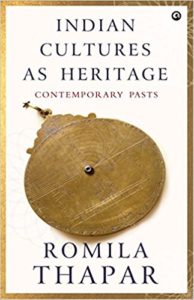Romila Thapar “Indian Cultures as Heritage: Contemporary Pasts”
 Renowned historian Romila Thapar has recently published an extremely relevant Indian Cultures as Heritage: Contemporary Pasts. Her premise is how the centuries texts and monuments are mostly historical records of elite cultures that “received larger patronage and symbolized the patterns of life of dominant groups”. These over time were conveyed and became readily available symbols of heritage as opposed to the objects of the socially lower groups “whose less durable cultural manifestations often do not survive. This also predisposed people to associate culture as essentially that of the elite”.
Renowned historian Romila Thapar has recently published an extremely relevant Indian Cultures as Heritage: Contemporary Pasts. Her premise is how the centuries texts and monuments are mostly historical records of elite cultures that “received larger patronage and symbolized the patterns of life of dominant groups”. These over time were conveyed and became readily available symbols of heritage as opposed to the objects of the socially lower groups “whose less durable cultural manifestations often do not survive. This also predisposed people to associate culture as essentially that of the elite”.
According to her most early societies register inequalities. All men and women may be said to be equal in the eyes of God but they may at the same time be differentiated in the eyes of men and women. She argues that societies are not static and change their forms and rules of functioning. Cultures are a reflection of these social patterns, so they also change. Culture is constructed, determined, and preserved by institutions and social codes. It is within this framework she spends a chapter discussing how perceptions of women in Indian society and the role of caste in providing contexts to determining attitudes to Indian culture. Ultimately there is a process of socialisation which makes these codes of conduct acceptable and then are more or less cast in stone, being passed on as tradition. She examines how “the single category of ‘women’ is no longer viable, since women, like men, perform a variety of social functions. These conform to the section of society they belong, detemining much of their activity and their articulation, both of which are now seen as a crucial aspect of the larger pattern of living”. Prof. Thapar makes a fascinating case for how the “history of what was often described as ‘women in ancient India’, was a reiteration of what was said about the role of women in society, in the Dharmashastras. These were heavily male-oriented and not much attention was given to women other than unnerlining their subservience to men.” Whereas she argues that the position of women in society which was usually defined by rules of caste and patriarchy, in part revolving around their sexuality, would at times be subverted. This was particularly noticeable in their modes of renouncing the world as documented by non-Brahmanical and secular literature.
These outstanding essays discuss history as heritage and the “Indian culture” that we extrapolate from this inheritance. This need to understand and discuss culture is from how the study of the past has changed in the few decades particularly with the upsurgence of nationalism as evident in its desire to focus on charting history through objects. Listen to this talk where she clearly states that true nationalism is inclusive of all traditions and does not occur at the cost of one or the other religion. She recorded this a year before this book was released — “Our Shared Cultural Heritage”History as Heritage” ( Anhad India, 26 Feb 2017). As she says in this interview to journalist Manjula Narayan “The secularization of society is essential to ensure the existence of democracy. The need for the secular is not just to enable us to say that we are not a theocratic state, but is essential to the functioning of democracy. Democratic systems cannot exist where there are predetermined religious majority and minority groups that are treated as fundamental to the functioning of democratic institutions, such as in elections to the Lok Sabha. We have been combining religion and politics by observing laws that claim religious sanctity as the basis of civil laws. This is an impediment in a multi-religious society.” ( Hindustan Times, 9 March 2018)
Read and share this book widely. It is imperative to do so in these times.
Romila Thapar Indian Cultures As Heritage: Contemporary Pasts Aleph Book Company, Delhi, 2018. Hb. pp. 222 Rs 599
11 March 2018
